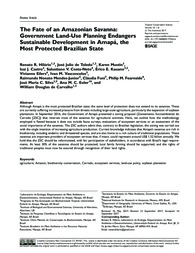The fate of an Amazonian Savanna: government land-use planning endangers sustainable development in Amapa, the most protected Brazilian State.
The fate of an Amazonian Savanna: government land-use planning endangers sustainable development in Amapa, the most protected Brazilian State.
Author(s): HILÁRIO, R. R.; TOLEDO, J. J. de; MUSTIN, K.; CASTRO, I. J.; COSTA-NETO, S. V.; KAUANO, E. E.; EILERS, V.; VASCONCELOS, I. M.; MENDES-JÚNIOR, R. N.; FUNI, C.; FEARNSIDE, P. M.; SILVA, J. M. C.; EULER, A. M. C.; CARVALHO, W. D. de
Summary: Although Amapá is the most protected Brazilian state, the same level of protection does not extend to its savannas. These are currently suffering increased pressure from threats including large-scale agriculture, particularly the expansion of soybean plantations. In September 2016, the Government of Amapá presented a zoning proposal (Zoneamento Socioambiental do Cerrado [ZSC]) that reserves most of the savannas for agricultural activities. Here, we outline how the methodology employed is flawed because it does not include fauna surveys, evaluations of ecosystem services or an assessment of the social importance of the savannas. The ZSC authors admit that, contrary to Brazilian legislation, the zoning was carried out with the single intention of increasing agriculture production. Current knowledge indicates that Amapa´?s savannas are rich in biodiversity, including endemic and threatened species, and are also home to a rich culture of traditional populations. These savannas are important providers of ecosystem services that, if intact, could represent around US$ 1.52 billion annually. We hold that the ZSC should be reformulated, with fair participation of stakeholders, in accordance with Brazil?s legal requirements. At least 30% of the savannas should be protected, local family farming should be supported, and the rights of traditional peoples must now be assured through recognition of their land rights.
Publication year: 2017
Types of publication: Journal article
Unit: Embrapa Amapá
Observation
Some of Embrapa's publications are published as ePub files. To read them, use or download one of the following free software options to your computer or mobile device. Android: Google Play Books; IOS: iBooks; Windows and Linux: Calibre.
Access other publications
Access the Agricultural Research Database (BDPA) to consult Embrapa's full library collection and records.
Visit Embrapa Bookstore to purchase books and other publications sold by Embrapa.

